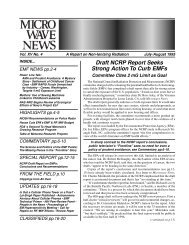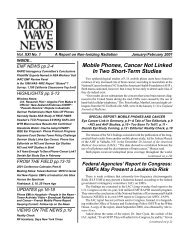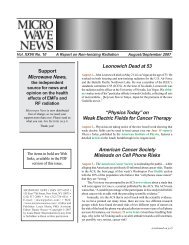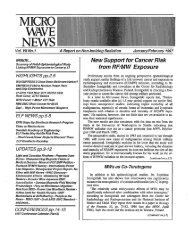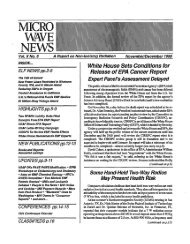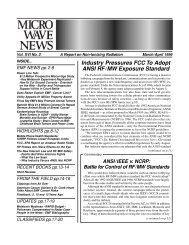Microwave News - November/December 1985
Microwave News - November/December 1985
Microwave News - November/December 1985
You also want an ePaper? Increase the reach of your titles
YUMPU automatically turns print PDFs into web optimized ePapers that Google loves.
HIGHLIGHTS<br />
nou. "I would be very surprised if they came up with any-<br />
thing new," he said.<br />
Kreiindler suspects that the satellite stations tumed down<br />
the power when the EPA came to town. "Usually TV re-<br />
ception in the valley is awful, but two days before the EPA<br />
anived, it cleared up. Then a few days after they left, it<br />
returned to normal," she said.<br />
Congresswoman Marge Roukema, who represents the<br />
Vernon area, has been monitoring the CDC and EPA stud-<br />
ies and has notified CAT that she is looking into the fed-<br />
eral government's efforts to set national exposure guide-<br />
-lies for non-ionizing radiation.<br />
EMC Society Meeting<br />
Outlined below are some of the highlights from the papers<br />
.<br />
presented at the <strong>1985</strong> IEEE International Symposium<br />
on Electromagnetic Compatibility (EMC), - held in<br />
Wakefield, MA, August 20-22.<br />
Isidor Straus gave a detailed overview of the German<br />
EMC bureaucracy, explaining how it is governed by dictives<br />
from the EEC (the Common Market). In "Meeting<br />
the VDE Requirements," he explained that the German<br />
rules have been "extensively reworked" in the last six<br />
months. Straus, of Dash, Straus & Goodhue in Boxborough,<br />
MA, described the legislative background of the<br />
mles and the groups that actually write the standards - for<br />
instance, he noted that the German DKE Subcommittee<br />
761 is the approximate counterpart of the U.S. ANS Committee<br />
C63 - and he went into considerable depth on the<br />
specific mles and measurement procedures.<br />
.With respect to U.S. standards, Edwin Bronaugh of<br />
What appears to be the fmt case of intentional<br />
electromagnetic interference (EMI) with a commer-<br />
cial satellite was reported to the Federal Communica-<br />
tions Commission in <strong>November</strong>. A complaint filed<br />
by Eastern <strong>Microwave</strong>, Inc., alleged that a tmnspon-<br />
der leased by the company on Hughes Communica-<br />
tions' Galaxy 1 satellite was subjected to 18 hours of<br />
EM1 from an unknown source in late October, ac-<br />
cording to Eastem <strong>Microwave</strong>'s attorney, Charles<br />
Helein of Dow, Lohnes & Albertson in Washington,<br />
DC.<br />
The Home Satellite <strong>News</strong>letter, which broke the<br />
story, noted that a home satellite dish can be cheaply<br />
tumed into an uplink transmitter that can interfere<br />
with any domestic satellite - "U.S. satellite com-<br />
munications could be held hostage by jammers," the<br />
Arlington, Vuginia newsletter wamed.<br />
Revenge against broadcasters who scramble tele-<br />
vision programming is one widely cited motive for<br />
wanting to jam satellite signals. For instance, the<br />
- --<br />
Intentional Satellite EM/?<br />
Electro-Metric~ in Amsterdam, NY, reviewed the forth-<br />
coming SAE J1507 report on testing the susceptibility of<br />
motor vehicles to radiated signals in the frequency range<br />
20 MHz to 18 GHz. He explained how the facilities and<br />
procedures described by the SAE can be applied to the<br />
testing of the immunity of other large and complex elec-<br />
tronic systems .... Julius Knapp and Frank Rose of the Fed-<br />
eral Communications Commission (FCC) examined ways<br />
of simplifying and streamlining the commission's Part 15<br />
mles on RF devices -including low power transmitters<br />
and computers. One change they advocated is to divide the<br />
rules into those that apply to intentional and to uninten-<br />
tional radiators. They also suggested the possibility of<br />
combining mles for unintentional radiators with the noise<br />
Sits for industrial, scientific and medical (ISM) equip<br />
ment under Part 18. They noted that the commission has<br />
not yet scheduled action for an overall revision of P a 15,<br />
but that a proposal could be issued in early- 1986.. ..And<br />
Richard Fab'ma and Joseph Husnay, both of the FCC, de-<br />
scribed some of the practical problems of testing computer<br />
devices with the commission's MP-4 measurement proce-<br />
dures. They emphasized the importance of cahle placement<br />
and the configuration of the equipment for maximizing<br />
conducted and radiated signal levels -the configuration<br />
for maximum emissions also varies with frequency.<br />
Jane Clemmensen and John Meloy of SRI International<br />
in Menlo Park, CA, and Ralph Ferram of the Electric<br />
Power Research Institute in Palo Alto, CA, presented the<br />
results of tests of seven power tine conditioners, isolators<br />
and purifiers to filter out harmonics and noise generated by<br />
consumer electronic equipment. They found that these fil-<br />
ters could reduce the high frequency noise but often at the<br />
<strong>November</strong> issue of STV Magazine published a fic-<br />
titious story about an angry HBO subscriber who<br />
uses EMI to blackmail the satellite cahle network to<br />
stop scrambling.<br />
In a letter to the FCC, Helein wrote: "The nature<br />
of the signal (unmodulated), its clean quality, the<br />
length of interference, the times at which it occurs<br />
and the manipulation between [two transponders]<br />
suggest a strong possibility that the signal is being<br />
deliberately generated to create interference or some<br />
licensee is most negligent in its testing procedures.<br />
In either case the matter is of grave concern to East-<br />
em <strong>Microwave</strong>."<br />
Dan Warren, managing editor of Satellite Week, a<br />
Washington, D.C. newsletter, said in a telephone<br />
interview that "people in the industry are nervous,"<br />
adding that it is easy to interfere with satellites but<br />
very expensive to stop and practically impossible to<br />
catch the jammer.<br />
6 MICROWAVE NEWS ~ovem%erl~ecer?rber <strong>1985</strong>



